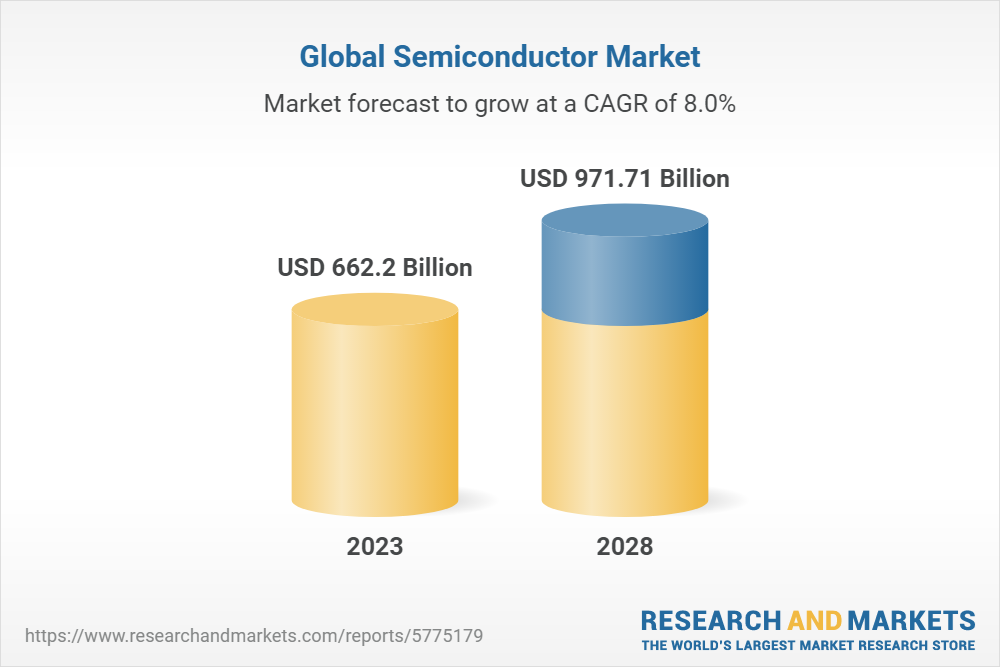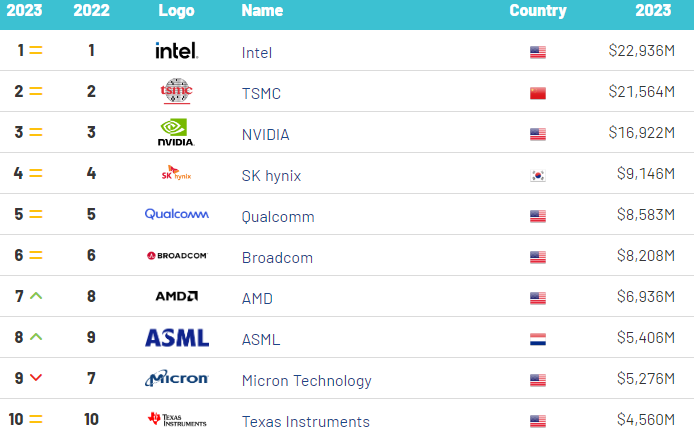20+ Mind-Blowing Semiconductor Industry Statistics, Facts, and Trends
Page Contents
Semiconductor Industry Statistics: The semiconductor industry is a key factor in the future of digital technology.
Technology is constantly evolving at an incredible pace. This is something that no one would dispute.
But do you know precisely what is happening?
For example, what is the one thing all our devices have in common, that we use so often in everyday life? You will find the answer in semiconductors, a substance with essential qualities, and is the subject of this article.
From the gadget on which you are reading this text to the mode of transportation you take to get to work, and everything in between, semiconductors are the connection that makes all of these machines work.
Stay with us as we review the most vital statistics from the semiconductor industry and reveal all the critical information you need to know about it!
Interesting Facts on the Semiconductor Industry's Size (Editor's Choice)

(Source: researchandmarkets.com)
- In 2023 the market size of the semiconductor industry across the world is going to be $662.2 billion.
- Whereas, by the end of 2029 the market size is going to be $1,380.79 billion with a 12.2% CAGR.
- 81% of global semiconductor industries are expecting to enhance revenue by the end of 2023.
- By the end of the 2nd quarter of 2023, around 52% of semiconductor industries claimed that the chip supply shortage will be resolved.
- By 2024, the revenue rates of the semiconductor industry will increase by 64%.
- Joe Biden, the US President, allocated $50 billion in 2021 for semiconductors.
- Hybrid electric vehicles can have up to 3,500 semiconductor chips.
- In the 2nd quarter of 2023, the semiconductor industry sold a record $124.5 billion in semiconductor chips with an increase of 4.7% which has decreased from last year.
- Samsung won the global semiconductor sales crown, with sales of roughly $83.09 billion.
- 70%of growth in the semiconductor sector is anticipated to be driven by just 3 industries.
- Samsung is the top semiconductor company.
- According to projections, the market would expand at a CAGR of 9.2% through the year
Semiconductor Facts
Let's start with the basics before we get into more detail about semiconductors.
Here are some important facts about the semiconductor industry.
#1. Joe Biden, the US President, allocated $50 billion in 2021 for semiconductors.
Joe Biden unveiled his $2 trillion infrastructure plan at the end of March 2021, intending to rescue the United States from the effects of the COVID-19 pandemic. 50 billion were explicitly reserved for research and manufacturing of semiconductors. It is confirmed when the president takes the US semiconductor industry so seriously.
According to World Semiconductor Trade Statistics, global annual sales have decreased by 10.3% in 2023.
The sales rate of semiconductors in the United States has increased by 6.3%. (Source: CNBC)
#2. There are four significant types of semiconductor chips.
Semiconductors can be described as substances whose electrical conductivity is easily changed by various techniques. Memory chips, standard chips, systems-on-a-chip (SoCs), and microprocessors are the four primary types of semiconductors. In addition, They all are used to make ROM and RAM modules, GPUs, CPUs, automobiles, ASICs, computers, telephones, factories, etc. We would never be able to cover everything on the list because it is so lengthy. You can now see why semiconductors are so crucial.
(Source: Investopedia)
#3. Global semiconductor sales have increased in 2023.
The list of tragedies and disasters caused by the COVID-19 pandemic is quite long. The global chip shortage is one of the items on it. It happened at an awful time since the demands were at an all-time high.
Nevertheless, the sale of semiconductors in the 2nd quarter of 2023 accounted for $124.5 billion, making it yet another successful year for the industry. Considering the circumstances, the results are reasonably respectable, although they are significantly less than in 2022.
In the 1st quarter of 2023, the global sales were $41.5 billion with an increase of 1.7% compared to the previous month.
(Source: Statista)
#4. Hybrid electric vehicles can have up to 3,500 semiconductor chips.
Cars have, on average, approximately 3,000 semiconductor chips, but hybrid electric vehicles may have more than 3,000 chips.
(Source: CRS Reports)
#5. In 2023, the semiconductor industry sold a record $634.5 billion in semiconductor chips.
The industry sold $634 billion in units of semiconductors in 2023. This was due to chip manufacturers increasing production to meet the high demand and the global shortage.
Whereas, by the end of 2032 semiconductor chips selling resulted in $1,124.5 billion with 7.1% of CAGR by the end of 2032.(Source: Semiconductor Industry Association)
Worldwide semiconductor revenue
- In 2023, the monthly sales of semiconductors in America have increased by 4.2%.
- Furthermore, other region statistics of global semiconductor sales have increased in China (3.2%), Japan (0.9%), and Europe (0.1%)
- Whereas, sales rate have decreased in the Asia Pacific region (0.5%)
#6. Top semiconductor producers are primarily based in the United States and Taiwan.
The two most notable ones are already well known to you: Samsung in the United States and TSMC in Taiwan. What are the other 8 companies on the top 10 list, then? Samsung and TSMC are closely followed by United States GlobalFoundries, Taiwan's UMC, and China's SMIC.
The market share for the next five companies is 1%: PSMC, HH Grace, DB HiTek, Tower Semiconductor, and VIS. As you may have predicted, most companies are Taiwanese or Chinese.
(Source: Visual Capitalist)
#7. The most well-known manufacturer of semiconductors is TSMC (The Taiwan Semiconductor Manufacturing Company), with a market capitalization of $600 billion.
In terms of manufacturing electronic chips, the company is larger than Samsung. Its semiconductor market share stands at 54%. Despite being the largest company in the world, Samsung's semiconductor market share is just 17%.
In addition, Samsung and TSMC are the only two semiconductor manufacturing firms capable of producing the 5 nm chip used by Apple, Intel, and Nvidia.
The Taiwanese company also plans to start commercial production of a 3nm chip in the second half of 2023.
(Source: Visual Capitalist)
#8. The world's largest manufacturer of semiconductors is Intel.

The industry’s biggest event of 2023 was the conflict between Intel and TSMC. According to semiconductor industry statistics, Intel continued to lead in annual revenue. Revenue earned by Intel is $22,936 million while TSMC accounted for $21,564 million in global revenue.
Whereas, other manufacturers' earned revenue is followed by NVIDIA ($16,922 million), SK Hynix ($9,146 million), Qualcomm ($8,583 million), Broadcom ($8,208 million), AMD ($6,936 million), ASML ($5,406 million), and Micron Technology ($5,276 million).
(Source: IT Brief)
#9. Worldwide revenue loss of $500 billion due to the shortage of semiconductor chips.
Data from the Semiconductor Supply Chain shows that revenue has dropped by more than half a billion dollars due to difficulties experienced by the companies and their customers.
In 2023, the worldwide revenue of semiconductors has decreased by 11.2% 2023 and is forecasted around $52 billion.
(Source: Deloitte)
#10. 70% of growth in the semiconductor sector is anticipated to be driven by just 3 industries.
Wireless, data storage, automotive, and computation are the fastest-growing segments of the semiconductor market. The semiconductor market is predicted to increase mainly owing to the automotive sector, where the need for chips may triple due to the production of autonomous cars and e-mobility.
(Source: McKinsey and Company)
#11. In 2023, Foundry’s capital expenditures grew to $156 billion.
The 2023 foundry capital expenditure was $156 billion. This is a 14% drop from last year 2022.
Below are the records of capital expenditure in the semiconductor industry between 2019 and 2021 by product type. (Source: Statista)
#12. Intel won the global semiconductor sales crown, with sales of roughly $43.2 billion.
The two most prominent manufacturers of semiconductors are Intel and TSMC. Intel regained market dominance in 2023 with global semiconductor sales of approximately $43.2 billion an increase of 2.3% from 2022.
(Source: Statista)
#13. From 2023 to 2028, the United States’s semiconductor market expanded by 8.40%.
According to SIA and their semiconductor market analysis, the semiconductor industry in the United States experienced an 8.40% annual growth rate and reached $112.19 billion in total yearly sales by the end of 2027.
#14. The market size for the semiconductors materials industry in the Asia Pacific region in 2023 is expected to be $25.22 billion.
Market revenue for semiconductors in the Asia Pacific region increased from $25.22 billion in 2023. By the end of 2029, the market is anticipated to be $29.80 billion with a 3.40% CAGR.
(Source: Fortune Business Insights)
#15. The market share of US semiconductor manufacturing capacity has decreased by more than 10%.
As new nations entered the market during the past 8 years, the proportion of American semiconductor production capacity around the globe has declined by more than 10%.
(Source: Semiconductor Industry Association)
Statistics for the Semiconductor Sector in 2023
Semiconductors saw a massive increase in 2023, but have now fully recovered.
The sector is booming just two years later, and 2022 appears to be a very prosperous year for them.
Let's find out how much!
#16. According to many sources, the industry's revenue is expected to exceed $600 billion in 2022.
For instance, Deloitte predicts a growth of 10% in 2022 to reach at least $600 billion in revenue. How else could it be otherwise? This sounds like a very acceptable course of action given their influence.
(Source: Deloitte)
#17. Sales of semiconductors worldwide increased by 7.42% CAGR between the years 2023 to 2027
A total of $151.7 billion worth of semiconductors were sold globally in Q1 of 2022. A little after the end of April 2022, the SIA made the announcement.
In the semiconductor industry sales around the world resulted in $40.0 billion by the end of 1st quarter of 2023 with an increase of 0.3% compared to March 2023 accounting for $39.8 billion
Market Growth Despite A Global Chip Shortage
Semiconductors are performing amazing despite the acute chip shortage that began in the first half of 2020.
but in 2023 the shortage is recovering.
In 2023 the output has reached about 85.6 million units and by the end of 2028, it will be 94 million units.
The business is booming because the demand much outweighs any deficits.
#18. The market is anticipated to expand at a compound annual growth rate of 9.2% each year until 2029.
The semiconductor sector appears to have a promising future. By the end of 2029, this market may be worth $893.1 billion. Fortune Business Insights thinks that the market could have been influenced by COVID-19 pandemic demand, IoT (Internet of Things) development, AI, and machine learning.
(Source: Fortune Business Insights)
#19. The global semiconductor market generated $552.9 billion in revenue in 2021.
The industry had a great start to 2022. Global sales should surpass $552.9 billion in revenue in 2021! Although there may have been a shortage of chips, it appears that this just increased demand. What do you think the number will be in 2022?
(Source: Statista)
Demographic Statistics
#20. White engineers make up 68.1% of the total.
Over half of all semiconductor engineers in the world are White. Asian semiconductor engineers make up only 16% of the workforce, and Hispanic or Latino engineers make up 9.8%.
(Source: Zippia)
#21. In the US, for every dollar men earn, female semiconductor engineers make $9.50.
In the US, the average salary for male engineers is $98,934. Their female counterparts' wages are lower; women semiconductor engineers make approximately $94,255.
(Source: Zippia)
#22. 10.7% of engineers working in semiconductors are women.
There are significantly fewer women engineers in the semiconductor industry than men. The US has 89.3%, male semiconductor engineers, while the less than 11% of female.
In addition, that represents the lowest proportion of female semiconductor engineers in a single year over the previous ten years. From 2010 to 2019, that percentage varied between 13% and 16%.
(Source: Zippia)
Conclusion
That's it all for today, everyone!
The semiconductor industry ranks among the most rapidly growing industries worldwide. According to statistics about the semiconductor market size, the sector will continue its growth due to an expected rise in demand, particularly after the shortages occurring in 2020-2021.
But it's (probably) more than enough to give you a glimpse of the semiconductor power. Investors need to keep track of the key statistics and trends in order to capitalize on the opportunities in this industry.
Our collection of notable semiconductor industry stats shows additional evidence of their expanding influence and demand.
Just be mindful of the continued shortage—while the market is still expanding, it is impossible to predict when the following catastrophic incident will occur.
Thank you for reading! I hope this article has been informative and helpful.
Sources
FAQ.
Worldwide Semiconductor Technology and Supply Chain Intelligence from International Data Corporation (IDC) predicts that semiconductor revenues will reach $661 billion by 2022. This is a 13.7% increase year-over-year.
In 2021, the global semiconductor market was valued at USD 452.25 billion. Market size is expected to increase from USD 483.00 billion in 2022 to USD 893.10 billion by 2029, at a CAGR 9.2% over the 2022-2029 period.
The global semiconductor industry has committed to increasing its overall production capacity at an unprecedented rate. From 2021 to 2023, capital expenditures by the three biggest players will likely surpass $200 billion. The government has committed hundreds of billions more.
By 2027, the market for semiconductors will reach $726.73 Billion. The most widely used semiconductor device is the metal-oxide-semiconductor field-effect transistor (MOSFET).
Optimizing sales and marketing of semiconductor technology. Over the past century, semiconductor sales has been steadily growing. Experts predict that the industry will reach $542.64 billion in annual revenue by 2022. This means that the market for semiconductor sales and marketing should grow.
Pat Gelsinger, CEO of Intel, now predicts that the semiconductor industry will experience shortages up to 2024. CNBC's CEO explained that the delay in the chip crunch was due to a shortage of manufacturing equipment. Intel reported Thursday that its fiscal second quarter guidance was weaker than expected.

Barry is a lover of everything technology. Figuring out how the software works and creating content to shed more light on the value it offers users is his favorite pastime. When not evaluating apps or programs, he's busy trying out new healthy recipes, doing yoga, meditating, or taking nature walks with his little one.



